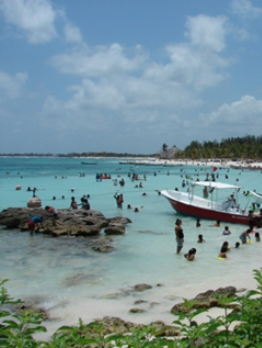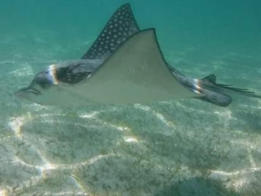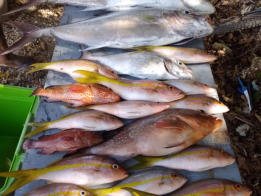


Caribeños de
Akumal.com


Caribeños de Akumal


Akumal.
About Akumal
Much of the current territory of the municipalities of Tulum and Solidaridad, in the Mexican Caribbean, belonged to the Cacicazgo of Ecab, including, among others, the towns of Tulum, Cobá, Xaman-há (present-day Playa del Carmen), Tancah, and Polé. Spanish chronicles describe Tulum as a city as large as Seville. The region was conquered in 1526 by Francisco de Montejo, who founded the Villa de Salamanca, where Xel-Ha is currently located. During the colonial era, the region remained almost uninhabited, and it wasn't until the last century that settlements were established for the exploitation of coconut, chicle, and timber. In the 1930s, Quintana Roo was dismembered as a federal territory, remaining under Yucatecan administration. In 1935, the then President of the Republic, General Lázaro Cárdenas del Río, restored the Federal Territory of Quintana Roo. Around 1970, the area's tourism vocation was boosted by the start of infrastructure work for the construction of the first hotels in a new destination: Cancún, which culminated in its consolidation two decades later as one of the most important tourist sites in the world. With the continued development of tourism activity along the Cancún-Tulum corridor, the necessary social and economic conditions were created, culminating on July 27, 1993, when the VII Legislature of the Free and Sovereign State of Quintana Roo decreed the formation of the Municipality of Solidaridad, with its municipal seat in the city of Playa del Carmen. In the so-called Riviera Maya, the creation of tourism development centers along the coastal highway, as well as new human settlements, are proposed to support these tourist destinations. Akumal is located 68 km from Tulum International Airport and 100 km from Cancun Airport, and is surrounded by various archaeological ruins and cenotes. Currently, Akumal is part of the Municipality of Tulum. However, Akumal's origins date back to 1958, when Don Pablo Bush Romero purchased most of the land on the Akumal dune. He founded the Aquatic Exploration and Sports Club of Mexico (CEDAM), promoting underwater exploration and nature tourism in the area. The first hotels and properties were then built along Akumal's coastal area, centered around a nascent nautical tourism activity, primarily restaurants, SCUBA diving, and sport fishing, both from boats and by underwater spearfishing. Since 1975, the first formal human settlements in Akumal began, with the authorization in the official gazette of the Quintana Roo State Government on January 20th of a subdivision known as Akumal Norte and Akumal Sur, located between Yalkú Cove and Aventuras Akumal. The owners and hoteliers of what was then Akumal promoted the creation of the town of Chemuyil, where their employees in the then-nascent tourism industry generally lived. The site currently occupied by the town of Akumal was established in 1995 on land granted by INVIQROO (now SEDUVI) to the inhabitants of the irregular settlements in the coastal area of Akumal, as well as those resulting from the growth and subsequent increase in social conflicts in Chemuyil. During those years, the presence of environmental authorities in the area was scarce, and activities increased, despite the great natural appeal of Akumal's coastal ecosystem. Until 1993, members of the Akumal Yacht Club donated a property on Akumal beach to create a non-profit environmental organization, the Ukana I Akumal Center, A.C., known as the Akumal Ecological Center (CEA), with the vision of creating an ecological tourism destination in the Mexican Caribbean. The unique local community of Akumal, made up of foreigners from around the world and Mexicans from different parts of the country, has been, like no other in Quintana Roo, traditionally concerned and involved in various conservation and environmental management strategies, based on Akumal's rich coastal marine ecosystem. Over the years, management strategies for Akumal's ecosystems have been developed and promoted through research, monitoring, training, education, and environmental management. Based on all these strategies, a wide range of tourism and non-extractive wildlife exploitation activities are currently being developed in Akumal, regulated by authorities such as SEMARNAT (National Secretariat of Tourism), CONANP (National Commission of Natural Resources), SEMAR (Secretariat of Tourism), and SADER (National Development Agency). A high percentage of the local population is dedicated to tourism services, including hotels and vacation accommodations, which in Akumal alone represent more than 60% of the rooms offered in the municipality of Tulum.Did you know that…
Akumal is one of those exceptional, albeit relict, sites, privileged for its diverse environments, including lowland evergreen forest, lowland flooded forest, savanna, flooded palm forest, cenotes, coastal lagoons, coastal dunes, mangroves, coves, beaches, reef lagoons, seagrass beds, and coral reefs. These environments support rich biological communities with varying conservation statuses. The Akumal reefs are part of the Mesoamerican Reef System (MAR), considered the second largest barrier reef in the world and home to thousands of species of flora and fauna, some of which are considered threatened or subject to special protection. The barrier reef off Akumal Bay creates a shallow, wave-powered lagoon with seagrass beds, diverse corals, several species of fish, and juvenile sea turtles, all of which guarantee very attractive environmental conditions for snorkeling. The sea's power in the bay generally does not pose a threat to the safety of visitors, who enter the generally clear waters by swimming or aboard boats. The climate in the region is warm-subhumid, with an average temperature of 24.9°C and an annual fluctuation of approximately 3.5°C. The average humidity is 70%, originating from the Caribbean Sea, which favors high rainfall in the region, with an average annual rainfall of 1,104 mm. The average wind speed is 12 km/h, predominantly from the southeast, interrupted by "northern" winds or other atmospheric phenomena that intensify the wind regime above 27-30 km/h. However, when these winds come from the south, east, and southeast, they create low visibility conditions caused by the re-suspension of sediments, as well as relatively strong drift currents, which could be dangerous for swimming in the bay, both for people and the marine ecosystem. The ease of access to the area from the beach and the high diversity of flora and fauna in a relatively small area (approximately 1,600 m2) have made Akumal Bay an attractive and affordable option for local and foreign visitors.













Sito en Español click en la bandera


Caribeños de
Akumal.com

Caribeños de Akumal.
About Akumal
Much of the current territory of the municipalities of Tulum and Solidaridad, in the Mexican Caribbean, belonged to the Cacicazgo of Ecab, including, among others, the towns of Tulum, Cobá, Xaman-há (present- day Playa del Carmen), Tancah, and Polé. Spanish chronicles describe Tulum as a city as large as Seville. The region was conquered in 1526 by Francisco de Montejo, who founded the Villa de Salamanca, where Xel-Ha is currently located. During the colonial era, the region remained almost uninhabited, and it wasn't until the last century that settlements were established for the exploitation of coconut, chicle, and timber. In the 1930s, Quintana Roo was dismembered as a federal territory, remaining under Yucatecan administration. In 1935, the then President of the Republic, General Lázaro Cárdenas del Río, restored the Federal Territory of Quintana Roo. Around 1970, the area's tourism vocation was boosted by the start of infrastructure work for the construction of the first hotels in a new destination: Cancún, which culminated in its consolidation two decades later as one of the most important tourist sites in the world. With the continued development of tourism activity along the Cancún-Tulum corridor, the necessary social and economic conditions were created, culminating on July 27, 1993, when the VII Legislature of the Free and Sovereign State of Quintana Roo decreed the formation of the Municipality of Solidaridad, with its municipal seat in the city of Playa del Carmen. In the so-called Riviera Maya, the creation of tourism development centers along the coastal highway, as well as new human settlements, are proposed to support these tourist destinations. Akumal is located 68 km from Tulum International Airport and 100 km from Cancun Airport, and is surrounded by various archaeological ruins and cenotes. Currently, Akumal is part of the Municipality of Tulum. However, Akumal's origins date back to 1958, when Don Pablo Bush Romero purchased most of the land on the Akumal dune. He founded the Aquatic Exploration and Sports Club of Mexico (CEDAM), promoting underwater exploration and nature tourism in the area. The first hotels and properties were then built along Akumal's coastal area, centered around a nascent nautical tourism activity, primarily restaurants, SCUBA diving, and sport fishing, both from boats and by underwater spearfishing. Since 1975, the first formal human settlements in Akumal began, with the authorization in the official gazette of the Quintana Roo State Government on January 20th of a subdivision known as Akumal Norte and Akumal Sur, located between Yalkú Cove and Aventuras Akumal. The owners and hoteliers of what was then Akumal promoted the creation of the town of Chemuyil, where their employees in the then-nascent tourism industry generally lived. The site currently occupied by the town of Akumal was established in 1995 on land granted by INVIQROO (now SEDUVI) to the inhabitants of the irregular settlements in the coastal area of Akumal, as well as those resulting from the growth and subsequent increase in social conflicts in Chemuyil. During those years, the presence of environmental authorities in the area was scarce, and activities increased, despite the great natural appeal of Akumal's coastal ecosystem. Until 1993, members of the Akumal Yacht Club donated a property on Akumal beach to create a non-profit environmental organization, the Ukana I Akumal Center, A.C., known as the Akumal Ecological Center (CEA), with the vision of creating an ecological tourism destination in the Mexican Caribbean. The unique local community of Akumal, made up of foreigners from around the world and Mexicans from different parts of the country, has been, like no other in Quintana Roo, traditionally concerned and involved in various conservation and environmental management strategies, based on Akumal's rich coastal marine ecosystem. Over the years, management strategies for Akumal's ecosystems have been developed and promoted through research, monitoring, training, education, and environmental management. Based on all these strategies, a wide range of tourism and non-extractive wildlife exploitation activities are currently being developed in Akumal, regulated by authorities such as SEMARNAT (National Secretariat of Tourism), CONANP (National Commission of Natural Resources), SEMAR (Secretariat of Tourism), and SADER (National Development Agency). A high percentage of the local population is dedicated to tourism services, including hotels and vacation accommodations, which in Akumal alone represent more than 60% of the rooms offered in the municipality of Tulum.Did you know that…
Akumal is one of those exceptional, albeit relict, sites, privileged for its diverse environments, including lowland evergreen forest, lowland flooded forest, savanna, flooded palm forest, cenotes, coastal lagoons, coastal dunes, mangroves, coves, beaches, reef lagoons, seagrass beds, and coral reefs. These environments support rich biological communities with varying conservation statuses. The Akumal reefs are part of the Mesoamerican Reef System (MAR), considered the second largest barrier reef in the world and home to thousands of species of flora and fauna, some of which are considered threatened or subject to special protection. The barrier reef off Akumal Bay creates a shallow, wave- powered lagoon with seagrass beds, diverse corals, several species of fish, and juvenile sea turtles, all of which guarantee very attractive environmental conditions for snorkeling. The sea's power in the bay generally does not pose a threat to the safety of visitors, who enter the generally clear waters by swimming or aboard boats. The climate in the region is warm-subhumid, with an average temperature of 24.9°C and an annual fluctuation of approximately 3.5°C. The average humidity is 70%, originating from the Caribbean Sea, which favors high rainfall in the region, with an average annual rainfall of 1,104 mm. The average wind speed is 12 km/h, predominantly from the southeast, interrupted by "northern" winds or other atmospheric phenomena that intensify the wind regime above 27-30 km/h. However, when these winds come from the south, east, and southeast, they create low visibility conditions caused by the re- suspension of sediments, as well as relatively strong drift currents, which could be dangerous for swimming in the bay, both for people and the marine ecosystem. The ease of access to the area from the beach and the high diversity of flora and fauna in a relatively small area (approximately 1,600 m2) have made Akumal Bay an attractive and affordable option for local and foreign visitors.

Akumal.


Sito en Español click en la bandera












